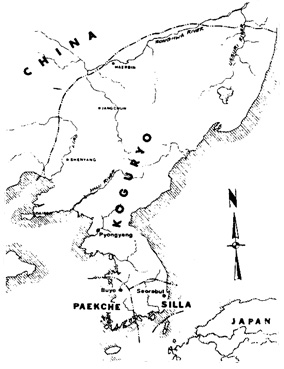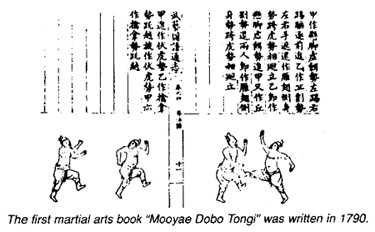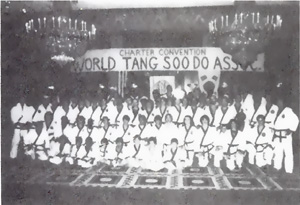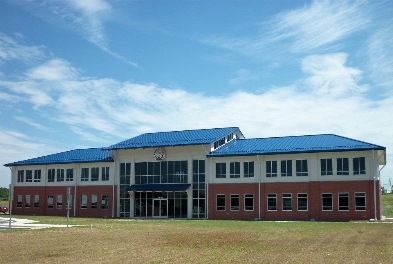|
|
Brief History
The exact origin of Tang Soo Do, as well as of any of the martial arts in general,
is obscure, though there are a number of historical theories. The most credible
and traditional view is that martial arts originated not in any one country, but
in almost all parts of the globe, as they were needed by primitive people.
|
Development in Early Ages
 The ancestral art of Korean Tang Soo Do can be traced back approximately 2,000
years. At that time, Korea was divided into three kingdoms. Koguryo was founded
in 37 BC in northern Korea. The Silla Dynasty was founded in 57 BC in the
southeast peninsula, and Paekche, in the southwest, was founded in 18 BC. After
a long series of wars, the Silla Dynasty united the three kingdoms in 668 AD.
During this period of time, the primitive martial arts were very popular in
warfare. This is evidenced by mural paintings, ruins and remains, which depicted
Tang Soo Do in those days.
The ancestral art of Korean Tang Soo Do can be traced back approximately 2,000
years. At that time, Korea was divided into three kingdoms. Koguryo was founded
in 37 BC in northern Korea. The Silla Dynasty was founded in 57 BC in the
southeast peninsula, and Paekche, in the southwest, was founded in 18 BC. After
a long series of wars, the Silla Dynasty united the three kingdoms in 668 AD.
During this period of time, the primitive martial arts were very popular in
warfare. This is evidenced by mural paintings, ruins and remains, which depicted
Tang Soo Do in those days.
Among the three kingdoms, the Silla Dynasty was most famous for its development of
martial arts. A corps formed by young aristocrats who were called
Hwa Rang Dan was
the major group who developed those arts. These warriors were instrumental in
unifying the peninsula as the new Silla Dynasty (668 AD-935 AD), and furnished
many of the early leaders of that dynasty. Most Korean martial arts trace their
spiritual and technical heritage to this group. The names of some groups and arts
reflect this, such as Hwa Rang Do or Hwa Soo Do. Our Five Codes of Tang Soo Do,
originated by Won Kwang, a monk, are part of their spiritual heritage.
|
Medieval Development
 The unified Silla Kingdom was overthrown by a warlord, Wang Kun, in 918 AD, and a
new kingdom, called 'Koryo,' lasted for 475 years. In 1392 AD the New Kingdom, the Chosun (Yi)
Dynasty, succeeded and lasted about 500 years. Approximately a thousand year
period elapsed between the two dynasties. Tang Soo Do became very popular among
the military society. However, most importantly, this art also became very popular
with the general public. In those days it was called Kwon Bop, Tae Kyun, Soo Bahk,
Tang Soo, etc.
The unified Silla Kingdom was overthrown by a warlord, Wang Kun, in 918 AD, and a
new kingdom, called 'Koryo,' lasted for 475 years. In 1392 AD the New Kingdom, the Chosun (Yi)
Dynasty, succeeded and lasted about 500 years. Approximately a thousand year
period elapsed between the two dynasties. Tang Soo Do became very popular among
the military society. However, most importantly, this art also became very popular
with the general public. In those days it was called Kwon Bop, Tae Kyun, Soo Bahk,
Tang Soo, etc.
The very first complete martial arts book was written at this time. This most
important book is called "Mooyae Dobo Tongji." It was written in 1790 AD and
contained illustrations that substantiate the theory that "Soo Bahk Ki," the
formal name of Tang Soo Do, had quickly developed into a sophisticated art of
combat techniques.
|
Modern Development
The subsequent occupation of Korea by the Japanese military regime took place from
1909 to 1945. During this period, practicing and teaching of martial arts were
restricted. After World War II, this restriction was lifted. Several martial arts
training schools were erected at that time, as follows:
|
|
Moo Duk Kwan
|
by Hwang Kee
|
|
Chi Do Kwan
|
by Kwai Byung, Yun
|
|
Chung Do Kwan
|
by Duk Song, Son
|
|
Song Moo Kwan
|
by Byung Jik, No
|
|
Chang Moo Kwan
|
by Nam Suk, Lee
|
|
Yun Moo Kwan
|
by Sang Sup, Chun
|
|
These founders started to organize their own organizations respectively, and
Master Hwang Kee organized the "Korean Soo Bahk Do Association" on November 9,
1945. Besides the Soo Bahk Do Association, there were various types of other
martial arts called "Kong Soo" or "Tae Soo" existing in Korea. In 1965, all of
these various systems were united into one organization, called the Korean Tae
Kwon Do Association and the art was called "Tae Kwon Do" uniformly.
As a Korean national sport, Tae Kwon Do initiated a new era. Instructors were
dispatched throughout the world and international tournaments were held. In those
days, Tang Soo Do and Tae Kwon Do were divided principally, with Tang Soo Do
striving to remain as a traditional martial art while Tae Kwon Do held its world
games and sports.
|
The World Tang Soo Do Association
 In 1968 Master Jae Chul Shin came to the United States of America as the U.S.
representative for the Korean Soo Bahk Do Association. He formed the United States
Tang Soo Do Federation in Burlington, New Jersey. The organization expanded to all
parts of America and foreign countries. This traditional and classical art was
quickly accepted and soon grew in popularity throughout America and the world.
After 14 years of Tang Soo Do promotion in the U.S.A. and the world, the
organization was reorganized to fit new international and domestic demands.
On November 13-14,1982, a Charter Convention for the World Tang Soo Do Association
was held in Philadelphia, Pennsylvania. At the Charter Convention a new constitution
was passed, a new logo and insignia were selected, the uniform and belt system were
revised, and new organizational standards were adopted. Most importantly, Master Jae
C. Shin was recognized as Grandmaster of the World Tang Soo Do Association.
In 1968 Master Jae Chul Shin came to the United States of America as the U.S.
representative for the Korean Soo Bahk Do Association. He formed the United States
Tang Soo Do Federation in Burlington, New Jersey. The organization expanded to all
parts of America and foreign countries. This traditional and classical art was
quickly accepted and soon grew in popularity throughout America and the world.
After 14 years of Tang Soo Do promotion in the U.S.A. and the world, the
organization was reorganized to fit new international and domestic demands.
On November 13-14,1982, a Charter Convention for the World Tang Soo Do Association
was held in Philadelphia, Pennsylvania. At the Charter Convention a new constitution
was passed, a new logo and insignia were selected, the uniform and belt system were
revised, and new organizational standards were adopted. Most importantly, Master Jae
C. Shin was recognized as Grandmaster of the World Tang Soo Do Association.
With proclamation of three mottos, Traditionalism, Professionalism and
Brotherhood, the advent of the World Tang Soo Do Association evoked the interest
of many international martial artists, whose genuine interest was in the Art, and
was not sport oriented. This organization has grown at an outstanding rate to
reach over 100,000 members in 36 countries. Thousands of students are training
in the following countries; Argentina, Australia, Belgium, Brazil, Bolivia,
Bulgaria, Canada, China, Chile, Columbia, Costa Rica, Czechoslovakia, England,
Germany, Greece, Guam, Holland, India, Italy, Korea, Mozambique, Mexico,
Pakistan, Peru, Philippines, Poland, Puerto Rico, Rumania, Russia, Scotland,
Seychelles, South Africa, Saudi Arabia, Sweden, Uruguay, and the U.S.A.
 In July of 2012, the WTSDA entered a new chapter with the Grand Opening of its new World Headquarters in Burlington, NC.
This was the fulfilliment of a dream for Grandmaster Shin, wo had strived to make this happen for over twenty years. Grandmaster Shin had the opportunity to see and work in this building prior to his passing on July 9th, 2012. According to his son, Robert, Grandmaster Shin's feelings were expressed with one simple word: "Wow."
In July of 2012, the WTSDA entered a new chapter with the Grand Opening of its new World Headquarters in Burlington, NC.
This was the fulfilliment of a dream for Grandmaster Shin, wo had strived to make this happen for over twenty years. Grandmaster Shin had the opportunity to see and work in this building prior to his passing on July 9th, 2012. According to his son, Robert, Grandmaster Shin's feelings were expressed with one simple word: "Wow."
Having become one of the most respected traditional martial art organizations, the
World Tang Soo Do Association is entering the new century striving for new
dimensional development.
|
|
|
|
|
|
|
|


